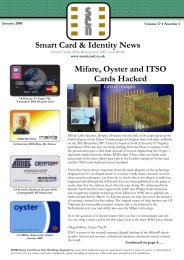Newsletter - June 1997 - Smart Card News
Newsletter - June 1997 - Smart Card News
Newsletter - June 1997 - Smart Card News
You also want an ePaper? Increase the reach of your titles
YUMPU automatically turns print PDFs into web optimized ePapers that Google loves.
<strong>Smart</strong> <strong>Card</strong> Tutorial<br />
Right:<br />
Figure 1<br />
The Classical<br />
Cryptographic Model<br />
Integrated Circuit <strong>Card</strong> Standards<br />
and Specifications - Part 9 :<br />
A Security Primer<br />
We have often questioned the use of <strong>Smart</strong> <strong>Card</strong>s and<br />
the necessary justification of the business case. It is clear<br />
that only when you require a secure portable carrier of<br />
data is there any case to be made for using the <strong>Smart</strong><br />
<strong>Card</strong>. In every other case there are far cheaper<br />
technological solutions. In this months discussion we are<br />
going to look at the security services that can be offered<br />
by a <strong>Smart</strong> <strong>Card</strong> and how such services are necessary in<br />
the emerging field of electronic commerce. In particular<br />
we must pay attention to both physical and logical<br />
security.<br />
Lets start our discussion by having a look at cryptography.<br />
Today cryptographic algorithms apply some<br />
mathematical transformation of the input data to produce<br />
a cipher. Sometimes, in the case of a one way function,<br />
this process cannot be reversed and the algorithm only<br />
acts in this single direction. In figure 1 we can consider<br />
the classical model..<br />
In modern cryptography the algorithm is usually public<br />
in that it is published and well known. Algorithms such<br />
as DES (Data Encryption Standard) and RSA (after the<br />
inventors Rivest, Shamir and Adleman) are referred to<br />
in almost any book on security. In this case the strength<br />
of the cryptographic process is entirely dependant on<br />
keeping the key secret. In a military environment the<br />
algorithm is usually kept secret (or heavily restricted)<br />
on the grounds that any information is useful to an<br />
opponent. In some cases the algorithm is kept secret on<br />
commercial grounds in that the inventors do not want to<br />
make their IPR (Intellectual Property Rights) freely<br />
available for all to copy or use. The use of patents may<br />
not be the best way to control the relevant commercial<br />
value. Regardless of the approach adopted the keys are<br />
fundamental to the overall process.<br />
If we refer to figure 1 we can see that the encipherment<br />
algorithm operates using key 1 on the input data to<br />
produce a cipher. The decipherment process uses key 2<br />
in order to recover the original message from the input<br />
cipher.<br />
When key 1 equals key 2 then this is referred to as a<br />
Symmetric Algorithm of which DES is a typical example.<br />
When key 1 does not equal key 2 then we are referring<br />
to an asymmetric algorithm. RSA is probably the best<br />
known example of an asymmetric algorithm.<br />
Symmetric cryptography is probably the easiest to<br />
understand because it is intuitive. The idea of processing<br />
the data with a key and then reversing this operation with<br />
the same key all seems to make sense. Lets look at what<br />
this means in practice (figure 2, opposite).<br />
The transmitter, using an algorithm such as DES,<br />
enciphers the message using his secret key. Clearly if<br />
the key is not kept secret then any eavesdropper on the<br />
network could decode the message. The resultant cipher<br />
is transmitted across the network where the intended<br />
receiver uses the same algorithm (in this case DES) and<br />
the same secret key to decipher the message. What is<br />
readily apparent here is that both parties must keep that<br />
key secret. If either one of them is careless in looking<br />
after the key then the security link is broken. The other<br />
point to notice is that if you find an enciphered message<br />
on the network you cannot tell just by looking at the<br />
cipher which party was responsible for its generation.<br />
Since both parties have the same algorithm and the same<br />
key, either could have generated the message. This is a<br />
very important consideration in a commercial<br />
environment and is particularly critical in electronic<br />
commerce where it is usually necessary to authenticate<br />
the source of a message.<br />
116<br />
<strong>Smart</strong> <strong>Card</strong> <strong>News</strong> <strong>June</strong> <strong>1997</strong>
















